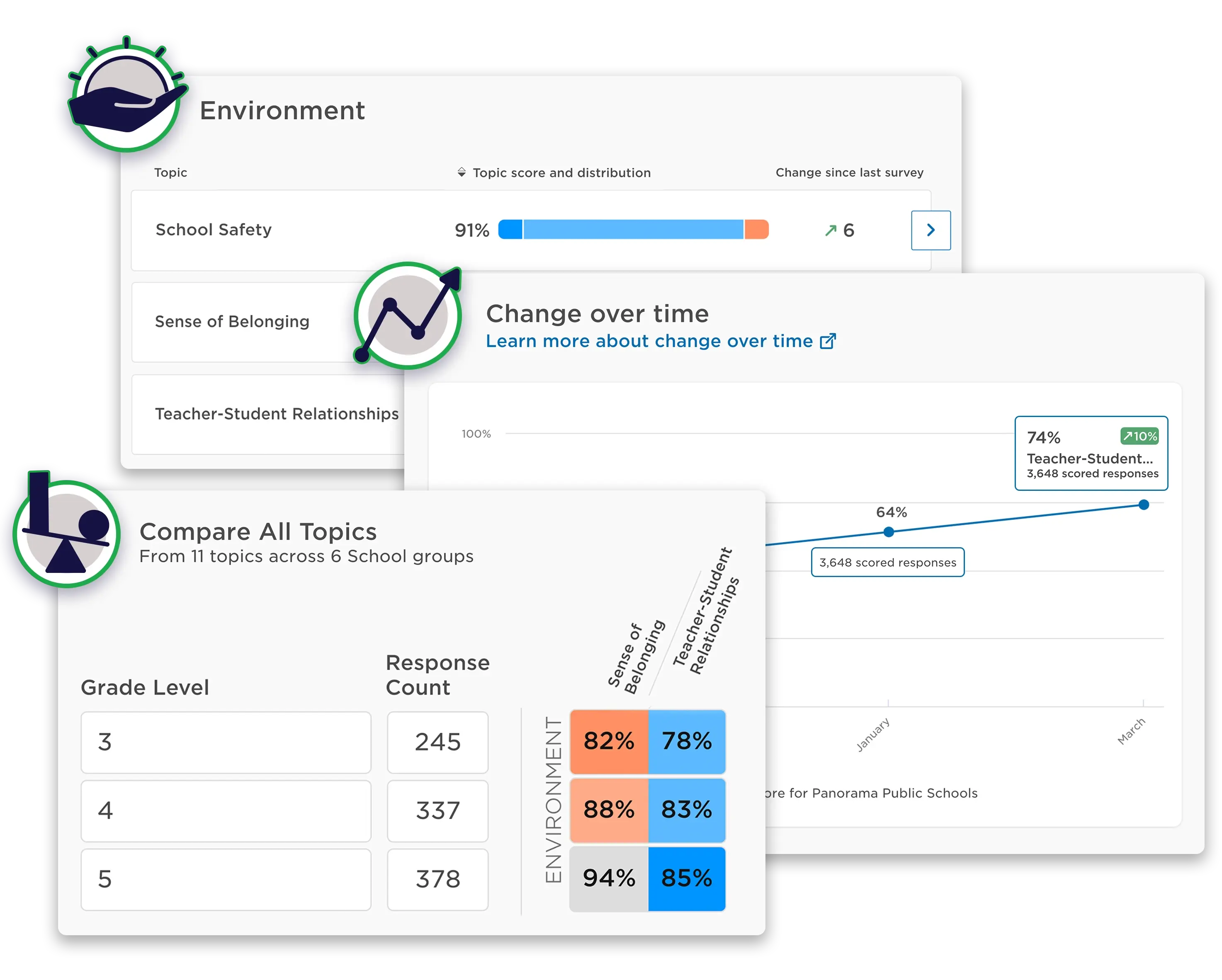Understanding school climate isn’t just about collecting data. It’s about knowing what that data is telling you and how to act on it. Surveys of students, families, and staff can reveal rich insights, but they also produce complex results that vary by grade level, school, and student group. Without a clear system for interpreting the findings, it’s hard to know which issues to tackle first.
That’s where strong school climate measurement comes in. With the right surveys and analytics tools, district leaders can confidently identify what matters most to their communities and focus their efforts where they’ll make the biggest difference.
Here’s how leading districts are measuring school climate today, and turning those insights into real solutions that help every student and educator thrive.
How Do Districts Measure School Climate?
Districts start by gathering feedback from students, families, teachers, and staff through school climate surveys. They pair these insights with other key data points—such as attendance records, course enrollment patterns, and student grades—to get a more complete picture of the learning environment. By analyzing these data sets together, district leaders can uncover connections between school climate and important outcomes like chronic absenteeism, teacher retention, and graduation rates.
Understanding School Climate in Today's Educational Landscape
School climate reflects the overall atmosphere of a school, from how supported students and teachers feel to how welcomed families are in the community. District and school leaders track these factors closely because research shows that a positive climate is linked to stronger academic performance, higher teacher retention, and better student attendance.
Here’s what that looks like for districts today:
The Four Domains of School Climate
Research shows that four key domains shape how students, teachers, and families experience school: safety, relationships, teaching and learning, and school environment. Understanding these areas helps district leaders identify strengths, spot areas for growth, and focus improvement efforts where they will have the most impact.
- Safety: Measures whether students and staff feel physically and emotionally safe at school, protected from bullying or harassment, and confident that adults will step in when problems arise.
- Relationships: Explores the strength of connections within the school community, including whether students feel supported by teachers, experience respectful interactions, and believe their voices are heard and valued
- Teaching and Learning: Assesses whether instruction is engaging and effective, feedback from teachers is constructive, lessons are relevant, and the school supports continuous learning and growth.
- School Environment: Examines the overall atmosphere of the school: whether it feels welcoming, rules are applied fairly, physical spaces support learning, and there is a positive energy that fosters belonging.
Why School Climate Matters More Than Ever
As teacher turnover rises and academic achievement gaps grow, school climate has become a top priority for many districts. Research shows that a positive climate not only boosts student achievement but also strengthens teacher retention. Students who feel safe and supported are 10 times more likely to make significant gains in reading and math than their peers in a poor school climate. Likewise, teachers in a supportive environment are less likely to experience burnout and 62% less likely to leave their school.
How Leading Districts Design School Climate Measurement Systems
School climate measurement is most effective when district leaders rely on research-backed surveys and focus the results on guiding improvement—not on evaluating individual teachers or staff. By asking the right questions and pairing survey insights with quantitative data such as graduation rates and teacher turnover, leaders can make informed, strategic decisions that drive better outcomes for both students and educators.
Here’s how districts can approach measuring school climate:
1. Select Research-Based School Climate Surveys
Poorly designed questions can lead to misleading data, wasted time, and misplaced efforts. K–12 districts should rely on vetted survey instruments that produce actionable insights. These typically fall into three categories:
- Student Voice – Captures classroom experiences, including perceptions of safety, access to resources, relationships, and life skills.
- Family Engagement – Provides insight into family attitudes toward their child’s education, school policies, and partnership with teachers.
- Teacher/Staff Surveys – Assesses working conditions, administrative support, professional development, and overall job satisfaction.
2. Administer Surveys Intentionally
Timing and consistency matter as much as the survey content. Conduct baseline surveys in the fall to identify priorities, then follow up in the spring to track progress. Boost participation by clearly communicating the purpose, offering surveys in multiple languages, and dedicating class time for students to respond. Always close the feedback loop by sharing results with participants—showing how their input leads to real change.
- Integrate Additional Indicators – Survey results tell only part of the story. Leading districts combine them with other key data to deepen their understanding:
- Attendance Patterns – Chronic absenteeism often signals underlying climate concerns.
- Behavior Data – Intervention records, suspension rates, and referral patterns across student groups.
- Course Enrollment – Participation in advanced classes, electives, and enrichment programs.
- Extracurricular Engagement – Sports, clubs, and other activities.
- Academic Trends – Grade patterns, assessment results, and graduation rates.
By analyzing survey findings alongside these indicators, districts can more accurately assess school climate and target initiatives where they will have the greatest impact.
Making School Climate Data Actionable for School Improvement
Districts may collect thousands of survey responses, but data alone doesn’t improve school climate—it’s how that data is analyzed, interpreted, and acted upon that drives change. Leading districts turn information into impact by:
1. Creating Informative Data Dashboards
Well-designed dashboards transform complex survey results into clear, accessible visuals. Teachers and staff need straightforward charts that show trends over time, highlight school-by-school comparisons, and pair climate scores with benchmarks and historical data. This context helps educators understand whether a percentage signals progress or concern. When done right, dashboards enable busy staff to quickly identify what’s working, spot challenges, and focus their efforts—without needing advanced data skills.
2. Analyzing for Disparities
A school may earn high ratings overall while specific student groups struggle quietly. Effective measurement systems allow users to filter data by factors such as ethnicity, special education status, English learner designation, and socioeconomic background. This granular view ensures resources are directed where they’re most needed. For example, districts may discover that new students feel isolated or that certain grade levels report higher stress—and can then design targeted interventions rather than broad, one-size-fits-all programs. This approach communicates to all students that their experiences matter.
3. Building School Climate Teams
Without accountability, even the most insightful data can go unused. Successful districts form school climate teams that represent the full community—administrators, teachers, support staff, and families. These teams meet regularly to review findings, select a few high-priority focus areas, and develop action plans with measurable goals. By concentrating efforts and tracking results, they ensure that school climate work is both manageable and impactful.
Strategies Districts Can Use to Improve School Climate
The districts that make the greatest strides in school climate share one defining trait: they act quickly on what the data reveals. Instead of getting bogged down in endless planning cycles, they select proven strategies and commit to following them through. While lasting change often takes two to three years, these districts understand that small, consistent actions create momentum far faster than ambitious plans that never get off the ground.
Here are the top tactics they use to foster a positive school climate:
Safety Interventions That Work
Districts use a range of strategies to create safer school environments:
- Restorative Practices – Replace punitive discipline with circles and conferences that repair harm and rebuild relationships.
- Trauma-Informed Training – Equip staff to recognize signs of trauma and respond with support rather than punishment.
- Peer Support Programs – Train students as mediators and mentors to resolve conflicts before they escalate.
- Communication Systems – Implement anonymous reporting tools and clear crisis-response protocols.
Building Stronger Relationships
Consistent, authentic relationships are the foundation of a positive school climate. Districts create structured opportunities for meaningful connections through:
- Advisory Programs – Small groups of students meet weekly with the same adult mentor throughout the year.
- Morning Meetings – Daily classroom circles foster community through greetings, sharing, and activities.
- Family Engagement Events – Cultural celebrations, learning workshops, and home visits strengthen school-family partnerships.
- One-on-One Check-Ins – Teachers schedule monthly individual time with each student.
Improving Teaching and Learning Environments
Districts invest in strategies that create engaging, supportive classrooms:
- Collaborative Planning Time – Provide weekly grade-level or department meetings to share strategies and align instruction.
- Student Voice Initiatives – Update curriculum based on regular student surveys and focus groups.
- Varied Learning Approaches – Incorporate project-based, hands-on, and technology-enhanced instruction.
Transforming Institutional Environments
Physical and policy changes can make schools more welcoming and inclusive:
- Visual Improvements – Add fresh paint, display student artwork, and create comfortable common areas.
- Policy Reviews – Audit discipline codes and dress policies to ensure fair and consistent application.
- Flexible Scheduling – Offer longer lunch periods, brain breaks, and varied class configurations.
- Multilingual Signage – Provide clear way-finding and welcome messages in community languages.
Building Staff Capacity for Data Use
Technology alone won’t improve school climate—without the right training, it’s just an expensive tool collecting dust. Successful districts invest in:
- Initial Training – Cover basic navigation, report generation, and data interpretation.
- Ongoing Coaching – Host monthly sessions that turn data discoveries into actionable plans.
- Peer Networks – Create regular forums where schools share strategies that work.
- Data Teams – Form dedicated groups to review findings and coordinate school-wide responses.
The key is to start simple—focus on one priority metric per school. As staff confidence grows, gradually introduce more complexity. Regular, hands-on practice with real scenarios builds skills and ensures that climate data becomes part of daily decision-making.
Why Panorama Education Is the Best Solution for School Climate Measurement
Improving school climate starts with truly listening to your community—and acting on what you learn. Panorama Surveys and Engagement is the leading K–12 platform for all your district’s survey needs, from benchmark surveys to quick pulse checks. It’s the central place to collect and analyze feedback from students, families, and educators on the factors that matter most for student success.
With reliable, research-backed data at your fingertips, your team can address critical areas like belonging, teacher–student relationships, engagement, and school safety. Panorama makes it simple to connect survey results to real outcomes, uncover disparities, and track progress over time—so you can turn insights into targeted actions that strengthen every school community.







